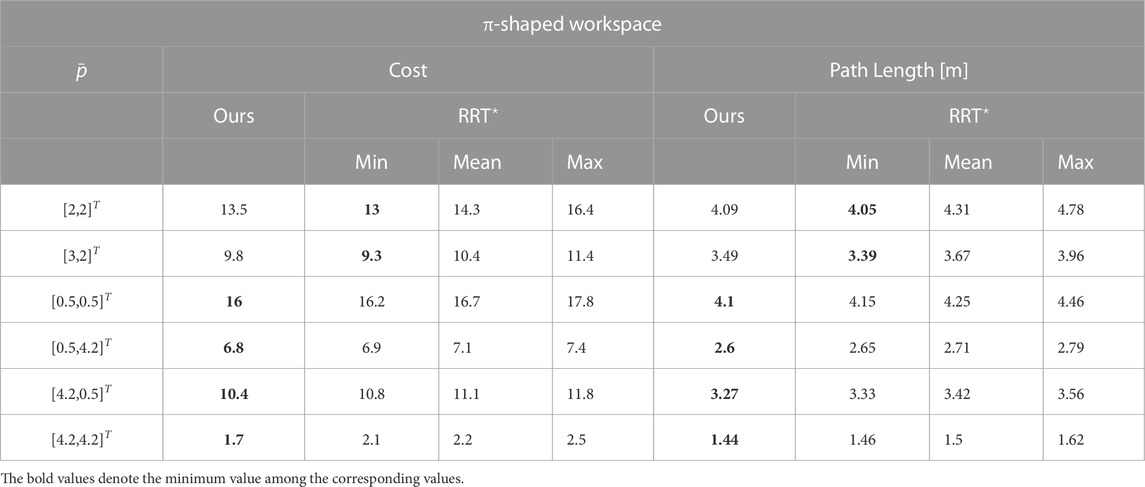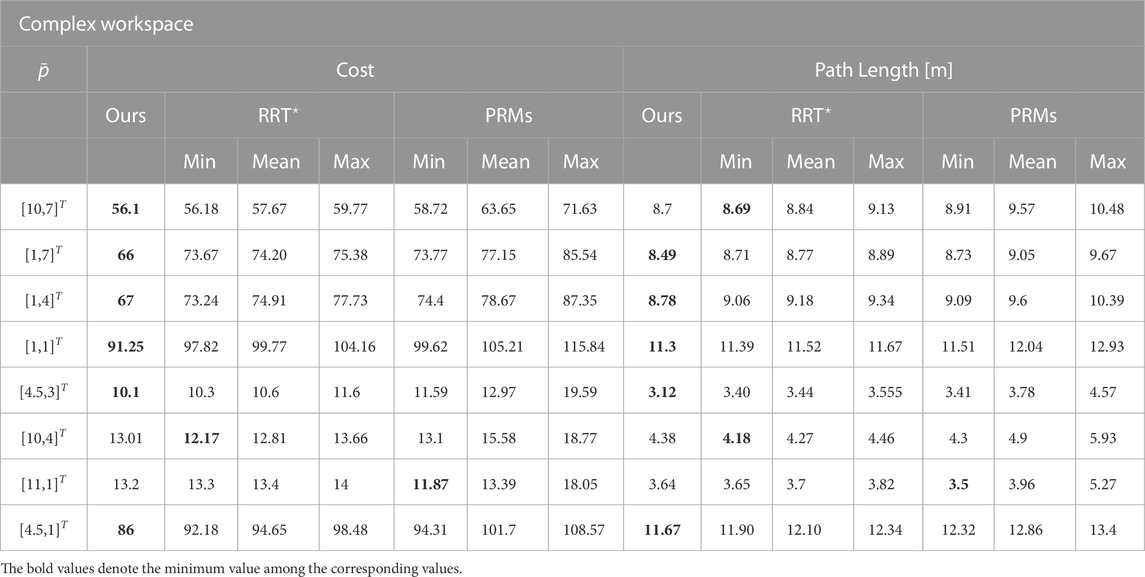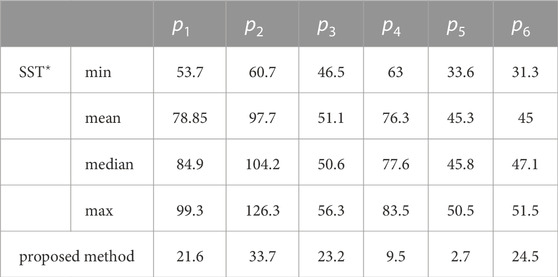- 1Control Systems Laboratory, School of Mechanical Engineering, National Technical University of Athens, Athens, Greece
- 2Division of Systems and Control, Department of Electrical and Computer Engineering, University of Patras, Patras, Greece
- 3Center of AI & Robotics (CAIR), New York University, Abu Dhabi, United Arab Emirates
In control theory, reactive methods have been widely celebrated owing to their success in providing robust, provably convergent solutions to control problems. Even though such methods have long been formulated for motion planning, optimality has largely been left untreated through reactive means, with the community focusing on discrete/graph-based solutions. Although the latter exhibit certain advantages (completeness, complicated state-spaces), the recent rise in Reinforcement Learning (RL), provides novel ways to address the limitations of reactive methods. The goal of this paper is to treat the reactive optimal motion planning problem through an RL framework. A policy iteration RL scheme is formulated in a consistent manner with the control-theoretic results, thus utilizing the advantages of each approach in a complementary way; RL is employed to construct the optimal input without necessitating the solution of a hard, non-linear partial differential equation. Conversely, safety, convergence and policy improvement are guaranteed through control theoretic arguments. The proposed method is validated in simulated synthetic workspaces, and compared against reactive methods as well as a PRM and an RRT⋆ approach. The proposed method outperforms or closely matches the latter methods, indicating the near global optimality of the former, while providing a solution for planning from anywhere within the workspace to the goal position.
1 Introduction
Motion Planning (MP), is one of the most fundamental problems in robotics (Latombe, 1999). Almost any resultant problem (from industry-related tasks, to social and collaborative ones) is irrelevant if a robot fails to autonomously perform safe and correct navigation. While in the industrial context such problems have been largely addressed, owing to highly restricted operating conditions and high task specificity, extending robotic capabilities for tackling any highly unknown, high-variance, and adaptive real-world environment is an active research field in modern robotics.
In order to tackle the above demanding problem, Data Driven methods (DT) and Machine Learning (ML) approaches (and more specifically Reinforcement Learning (RL)) (Brunton and Kutz, 2021) have been employed with remarkable results. Traditionally, robotics problems are treated as Control Theoretic (CT) problems, which are tackled through formal control design based on the aforementioned theoretical framework. RL methodologies treat such problems through learning a control policy via various methods that in general require exploration of a robot’s environment and the exploitation of gathered knowledge (data). The learning aspect of ML methods aims at addressing an integral feature of robotic platforms, namely, the concept of “Embodied Intelligence” (Roy et al., 2021) (i.e., the fact that embodied agents operate within and interact with realistic, highly varying, and uncertain environments).
However, even though ML researchers have provided some theoretical guarantees (Sutton and Barto, 1998), this rests in contrast to the CT paradigm, where provable guarantees are a design specification (e.g., see feedback linearization (Isidori, 1999) for convergence and prescribed performance control (Bechlioulis and Rovithakis, 2008) for output constraints). For example, in the context of the motion planning problem, there exist a variety of conventional algorithms that provide provable guarantees, whereas ML approachesmostly aim at achieving a desired control performance, without imposing the latter by design, hence, a statistical analysis may be applied to asses the effectiveness of the method. Considering the above, we propose a method that aims at taking a step towards bridging the identified gap in the context of the MP problem. In this case, the two perspectives, namely, the control theoretic reactive (feedback) design and RL-based optimization, are merged via a Policy Iteration (PI) approach. The design of a provably safe and convergent controller follows the CT philosophy, while at the same time, it is shown to provide successively ameliorating policies through the application of a RL-PI scheme. The proposed method concentrates around the off-line computation of the optimal velocity input for a class of holonomic agents, which is advantageous in cases where planning from many initial robot positions is necessary. Such environments include warehouses, where the workspace is a-priori known and robotic tasks most likely include many navigation instances within a robot’s workday, thus motivating our method’s scope.
1.1 Related work
The Path Planning problem, i.e., the definition of a geometric path given geometric constraints, has been extensively approached using Sampling-Based Methods (SBMs) (Karaman and Frazzoli, 2011) and/or discrete/graph-based approaches. These include, but are not limited to, Probabilistic Road Maps (PRMs) (Kavraki et al., 1996), Djikstra’s algorithm (Anastopoulos et al., 2009), Random Rapidly exploring Trees (RRT) (LaValle et al., 2001) and its variant RRT⋆ (Karaman and Frazzoli, 2011), A⋆ (Pearl, 1984) and D⋆ with its variant, D⋆-lite (Koenig and Likhachev, 2002). Owing to the rise in computing power, such methods have been widely celebrated, with significant extensions to improve their performance, or generalize their scope. RRT⋆ has more specifically seen significant development, through smart re-planning (Wang et al., 2020b) and extensions such as (Jaillet et al., 2008) for considering continuous cost formulations, and even dynamic workspaces (Wang et al., 2020a).
In contrast to discrete methods, continuous methods, like Navigation Functions (NFs) (Rimon and Koditschek, 1992) and Artificial Potential Fields (APFs), treat the problem through the design of potential functions over the robot’s workspace, such that they exhibit a single global minimum at the desired configuration. However, such methods are hard to tune in order to nullify any local minima that would inhibit convergence to the desired final position. A notable class of APFs, namely, Artifical Harmonic Potential Fields (AHPFs) (Loizou, 2011) have been employed in disk worlds, owing to lack of local minima inside their domain. Their limitations have also been treated through transformations of arbitrary workspaces into disk ones (Vlantis et al., 2018a), and the formulation of harmonic vector basis’ directly on the physical workspace (Kim and Khosla, 1991; Rousseas et al., 2021; Rousseas et al., 2022). The above methods are consistent with the reactive approach of CT, through the formulation of a continuous velocity vector field over the entire workspace of a robot, while providing convergence and safety guarantees for the resulting velocity field.
More recently, ML methods have been employed for a wide range of robotic planning problems, including MP. Long-Short-Term-Memory Networks (LSTMNs) (Inoue et al., 2019), Support Vector Machines (SVMs) (Weston and Watkins, 1999), Monte Carlo Tree Search (MCTS) with Neural Networks (Paxton et al., 2017), and Convolutional Neural Networks (CNNs) (Lei et al., 2018) belong to this class. Out of all the ML-related frameworks, the most relevant to this work is RL, where Q-learning and policy gradient have been employed (Zhou et al., 2022). More specifically, applications involve RL with PRM (Francis et al., 2020), where noisy sensors and complicated models are considered as well as Deep Reinforcement Learning (DRL) for visual navigation (Devo et al., 2020), where exploration and target-following tasks are considered. Another impressive DRL result is presented in (Miki et al., 2022), where a quadruped platform is demonstrated to tackle challenging, real-world environments.
Finally, with regards to more modern treatments of MP, several promising approaches have arisen, such as Non-linear Model Predictive Control (Grandia et al., 2022) and locally reactive controllers (Mattamala et al., 2022). Be that as it may (even though in general MPC can be employed to solve kinematic problems, albeit with large computational resources to avoid local minima), the above impressive and sophisticated controllers differ from our approach, as we treat the kinematic path planning problem. Furthermore, the scope of our method is not limited in the extraction of a single path; our method provides a velocity field for the entirety of a robot’s physical workspace and can thus be employed as a higher lever planning module in combination with a low-level motion planner for robotic platforms. In that sense, the proposed method is more similar to conventional planners, e.g., RRT⋆, in the context of path extraction in a physical workspace. Within the same paradigm, Model Predictive Path Integral (MPPI) control (Mohamed et al., 2020; Williams et al., 2017 exhibits certain similarities to our approach and is demonstrated to work in complex case-studies. However, since the depicted results in the above works are limited to workspaces with numerous, but small and most importantly convex obstacles, these approaches might be susceptible to local minima (especially in the partial observability case), as long planning horizons (which might be necessary to escape local minima) might be computationally infeasible. Regardless, these methods also provide a single-path solution to MP, whereas the goal of the proposed method is to provide a solution for the entire workspace (w.r.t. a single goal position) in a one-shot manner, such that it can be used for many arbitrary navigation instances (w.r.t. the given final goal position).
Regarding the optimal MP problem, the aforementioned methods A⋆, D⋆, and Djikstra’s Algorithm minimize the solution’s path length with provable optimality in some cases, while RRT⋆ can be modified to encompass kinodynamic constraints and more complex cost function forms. Furthermore, the latter is also proven to provide asymptotic optimality (at the limit of infinite run-time). In practice, satisfactory sub-optimal solutions can be obtained, or if desired, post processing can improve existing paths (Geraerts and Overmars, 2007). Concerning non-linear dynamics, the authors (Li et al., 2016) propose a methodology that treats such cases, which is especially relevant to the herein proposed method. On the contrary, there has been limited work on optimal reactive navigation, with some works including optimal NFs for stochastic systems (Horowitz and Burdick, 2014), where either a complete solution necessitates solving a hard Partial Differential Equation (PDE), or semi-complete treatments implement parameter tuning (Vadakkepat et al., 2000; Amiryan and Jamzad, 2015). It is therefore clear that sampling/graph-based methods have been explored extensively for the optimal MP problem, whereas reactive/continuous methods leave a lot of issues unresolved.
1.2 Contributions
Given the preceding discussion, we propose a method that merges the advantages of continuous methods with the RL-induced optimality through a PI method for 2-dimensional, planar optimal motion planning. The proposed framework additionally extends optimality to a set of non-linear, first order dynamics. More specifically, our contributions are.
1. A Policy Iteration algorithm that provides successively improving Reactive Motion Planning Policies,
2. A projection controller, such that safety during navigation and asymptotic convergence to the goal position are guaranteed, and
3. A workspace decomposition scheme that improves the computational performance of the proposed method.
The “reactive optimal motion planning problem” concentrates on the extraction of a reactive input vector field, defined over a robot’s workspace, such that a Cost Function is minimized. The novelty in the first two points lies in the fact that the proposed method is reactive in the technical, control theoretic sense; that is, the policy (velocity input) is explicitly dependent on the state (position) of the robot (feedback). While this might also be the case for many modern RL methods (where the term reactive is rarely employed), our work is aligned with the control theoretic paradigm of treating the evolution of Ordinary Differential Equations (ODEs) (as in the flows of vector fields) over manifolds. This also demonstrates the main difference between the proposed scheme and MPC-based ones; the herein proposed offline optimization enables extracting optimal trajectories from anywhere within the workspace, w.r.t. a given final position, without the need for re-running the method.
Therefore, the proposed optimal control problem essentially consists of a functional analysis problem, and requires the solution of a hard, non-linear, PDE. The RL-scheme is employed appropriately to construct the optimal input without necessitating the solution of the aforementioned PDE. Instead, the cost function gradient is successively approximated through gathered data, and at the same time CT is employed to provide safety, convergence, and policy improvement guarantees. As it will become apparent in the sequel, full knowledge of the dynamics does not enable extracting the cost function a priori, therefore successive approximation is necessary. For more details, the reader is directed to (Abu-Khalaf M. and Lewis F. 2005).
1.3 Outline
The rest of the manuscript is organized as follows: In Section 2.1, we formulate the problem in the language of control theory. Subsequently in Section 2.2, we present the proposed method and provide some formal analysis that motivates our approach. In Section 2.3, we prove the asserted technical claims of the method and continue with providing an overview of the scheme, along with some practical details in Section 2.4. In Section 2.5, a scheme for ameliorating the computational characteristics of the proposed method is presented. Finally, we present rigorous simulation results in Section 3, with the relevant figures included in a separate section for readability, and conclude with a relevant discussion and envisioned future prospects in Section 4.1.
2 Materials and methods
2.1 Optimal motion planning as an optimal regulation (OR) problem
Consider a point robot1 operating within a fully known, bounded (with external walls), and connected planar workspace
where
1. f is a Lipschitz continuous function for all
2. f vanishes at the desired position, i.e., pd is an equilibrium of system (1).
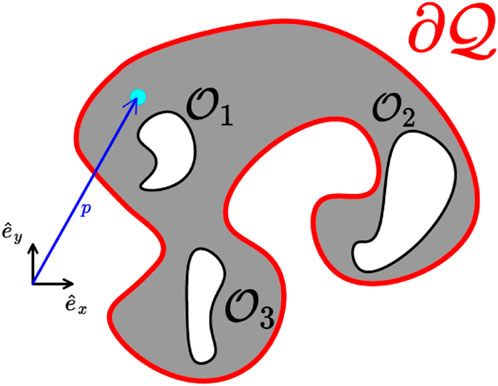
FIGURE 1. A workspace, whose outer boundary is depicted in a red line, and three obstacles depicted with black lines. A frame of reference along with an exemplary position (cyan disk), and the corresponding position vector (blue arrow) are also depicted.
Assumption 1 is common for addressing control problems and roughly concerns the absence of singularities inside the workspace. Assumption 2 is stronger and might not hold for real-world applications, however it will be shown in the sequel that it can be relaxed by applying a fixed translation to the input signal, i.e., u = u′ − f(pd), to render pd an equilibrium, where u′ denotes the new input command.
Remark 1. Form (1) is motivated by agents that operate within environments where, in addition to the velocity input, the external environmental interactions are modeled through a velocity field. For instances such as of an underwater vehicle operating in the presence of an external water flow (sea currents), the robot velocity depends on both the input, and the position-dependent flow (i.e., on the term f(p) in Eq. (1)) induced by the environment (Fossen, 1994). Since our work is limited to first order dynamics, the adopted model could be used as an approximation of the motion of a robotic vehicle in the presence of such an external fluid flow. Such an approach, although approximate, would still prove beneficial to address energy consumption, especially in slow-moving flows, if the underlying optimal velocity field is employed as a high-level velocity command to a low-level tracking controller. Tracking a straight line trajectory (the optimal path if fluid flow is neglected) towards a goal position would result in larger amounts of energy consumption compared to a trajectory incorporating fluid flow expressed in the adopted simplified velocity space. On the other hand, if one were to cancel the drift term f(p) and deal with a single integrator model then the solution would not be optimal (see (Freeman and Kokotovic 1996)), as the drift term may be advantageous in guiding the robot to the goal position (depending on the flow). Finally, the technical results provided in the sequel can easily be extended to systems of the form
The goal of this work is to design a reactive control input (i.e., a vector field)
where
where α, β are positive real-valued weighting constants and ‖ ⋅‖ denotes the Euclidean norm. The metric (2) along with (3) essentially result in a cost function from optimal regulation theory (Kalman, 1960). The state-related term Eq. 3a) can be understood as minimizing the settling time of the system, i.e., the time until the robot reaches an area close to the goal, since it penalizes the robot for staying away from the goal position as time evolves. The input-related term Eq. 3b) is more straightforward, as it penalizes the control input’s Euclidean norm, which, when integrated, roughly translates to actuator energy minimization.
The cost function
Which renders the limit of the integral (1) well-defined for asymptotically converging trajectories.
Finally, while the drift dynamics are assumed to be fully-known, we underline that the OR problem is still non-trivial; that is, the fact that neither the optimal cost function (2), nor the cost function gradient are readily available, renders the extraction of the optimal policy rather difficult, requiring the solution of a hard, non-linear PDE. In the sequel we bypass this limitation through the proposed RL-PI scheme.
2.2 Proposed method
In this section, the proposed PI scheme will be presented. First of all, we begin by defining the set of admissible policies which serves as a basis for designing a framework for a reactive solution with provable guarantees.
Definition 1. (Admissible Policy) A navigation policy
1. u is continuous on
2.
3.
4.
5. the resulting trajectories of (1) under the control law
2.2.1 Initial policy
In RL, the training process begins through the implementation of an initial, sub-optimal policy that serves as a starting point for the optimization algorithm. It is standard practice that the initial policy is acquired through its parametrization via an approximation structure and the initialization of its parameter vector. As will become apparent in the sequel, our policy is on the contrary parameter-free. However, a vector field that can be employed as a reactive4 and admissible initial policy is also required (see Def. 1). As discussed in Section 1.1, there exist a plethora of methodologies for providing provably correct reactive vector fields in the literature. In Rousseas et al. (2022), we have provided a method for obtaining such an initial policy, through an AHPF5:
where
Renders system (1) almost Globally Asymptotically Stable (GAS). The term “almost” relates to the topology of the workspace and is discussed extensively in the following subsection.
2.2.2 Impossibility of strictly global navigation in multiply connected workspaces
Prior to presenting the proposed scheme, it is necessary to discuss some properties of continuous vector fields over multiply connected manifolds (i.e., workspaces with internal obstacles). In their seminal work, Koditschek and Rimon (1990) proved how in multiply connected manifolds, no strictly globally attractive vector field can be defined. This limitation stems from saddle-points of the vector field, whose existence is guaranteed through the following proposition.
Proposition 1. (Corollary 2.3 in (Koditschek and Rimon 1990)). Let v be a smooth nondegenerate vector field on the free space,
We now employ the above proposition to show how limiting the vector field to the form (5), as introduced in Rousseas et al. (2022), presents the advantage of exhibiting as few saddle points as possible.
Proposition 2. Let
Proof. See Supplementary Appendix S1.
The above proposition essentially describes how AHPFs, owing to the minimum-maximum principle and the subsequent lack of any local maxima in the interior of a workspace7, induce only as many saddle points as the number of obstacles.
The restrictions on the existence of continuous reactive controllers in the presence of obstacles that are discussed in this section have recently been formalized and generalized through the notion of Topological Perplexity (TP) in Baryshnikov (2021). The effect of TP and the above propositions on our method is twofold: First of all, while Definition 1 can be employed in the context of simply connected manifolds (workspaces with no internal obstacles) and harmonic vector fields, this is not the case when internal obstacles are present. The hyperbolic equilibria (saddles), impart stable manifolds from which trajectories fail to reach the goal position. Additionally, any saddle of the Navigation Field will result in infinite cost for any point that starts exactly at the stable manifold of the former. This is proven in Proposition 3. Nevertheless, the aforementioned manifolds are of Lebesque measure one, therefore the probability of starting exactly on them (and thus the probability of the navigation failing) is zero. To formalize this notion, we adopt the definition of a stable manifold, Wst(ps) of the saddle point ps, s = 1, … , M from (Hsu, 2013)8:
where
Proposition 3. Given the harmonic navigation Field v in (5) the cost function (2), evaluated on trajectories of the system
Proof.See Supplementary Appendix S1.
2.2.3 Addressing multiply connected workspaces
The singularity that the cost function admits, and which was proven to exist in Proposition 3, yields technical and practical challenges for the application of the proposed PI scheme, as the approximation of functions with singularities is ill-posed. The proposed method is still applicable for obstacle-free workspaces, as the lack of internal equilibria is guaranteed through Proposition 2. We therefore propose applying our method in multiply connected workspaces through generating a transformed workspace
1. A region of finite area is rendered inaccessible for the robot,
2. The topology and geometry of the artificial-boundary regions directly influence optimality, i.e., a poor choice of such regions can hinder the optimality of the final controller (upon convergence).
However.
1. Such an initial subdivision of a multiply-connected workspace to a simply-connected one is unavoidable (be it through one-dimensional sets instead of two-dimensional ones) due to the presence of saddles,
2. The newly simply connected workspace admits Admissible policies, as per Definition 1,
3. The cost on the boundaries of the resulting harmonic navigation field is finite,
4. The regions can be rendered arbitrarily small, as long as they remain of measure-two.
The aforementioned step is thus a well-motivated and necessary one in order to formulate a PI scheme without sacrificing mathematical exactness. Negating the need for such a transformation is furthermore a promising future research direction that we intend to pursue. An example of this process is presented for a simple workspace in Figure 2. It can be shown that the herein depicted choice for linking the obstacle to the outer boundary might not be optimal for several choices of desired final robot positions (e.g., for pd positioned “within” the convex region defined by the π-shaped obstacle).
FIGURE 2. The Original Workspace, containing a π-shaped obstacle (left) with its Simply-Connected, Transformed Version (right). The obstacle is connected to the boundary through a slim region. The free part of the workspace is depicted in white, while the occupied part of the workspace is depicted in black.
In order to obtain a transformed workspace such as the one in Figure 2, we leverage Proposition 2, along with the method in Rousseas et al. (2022). Briefly, we initially obtain an AHPF through the method in Rousseas et al. (2022), for the multiply connected workspace. According to Proposition 2, the vector field (5) admits M saddles, each of which further consist of two (one-dimensional) manifolds, a stable and an unstable one (Hsu, 2013). It can be easily shown by contradiction that, for a safe AHPF with a sink at the workspace’s interior, the unstable manifold of a saddle connects the latter to the goal position, while the stable manifold connects the saddle to the boundary10. Consecutively, the saddles, along with their stable manifolds can be computed numerically, which essentially provides a set of curves that link the obstacles to themselves and/or the boundary. In order to turn the one-dimensional manifolds into the two-dimensional ones that are necessary for the method, simple algorithms can be implemented, such as a bounding box one. The respective field, along with the stable manifold and its bounding box, are depicted in Figure 3.
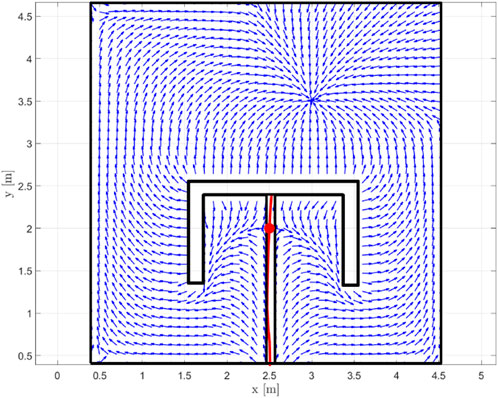
FIGURE 3. An AHPF for the multiply-connected obstacle, along with the saddle (red disk), the stable manifold (red, continuous line) and its bounding box (black) that is employed to render the workspace simply connected.
2.2.4 Policy iteration scheme
In this section, the proposed PI scheme is presented. In PI methods, the robot executes a sub-optimal policy and computes the related cost function (2), through a computationally expensive process. Subsequently, the acquired information is employed in order to ameliorate the policy w.r.t. to the cost function. This process is repeated until the cost function converges. While the computational cost of PI methods is significant, owing to the extensive cost data gathering, the convergence rate is fast (Brunton and Kutz, 2021), as in practice only a small number of training “epochs” (i.e., iterations) are needed. As the TP-related issues were discussed in Subsections 2.2.2 and 2.2.3, henceforth we treat the case where the initial policy exhibits no internal critical points, and we employ the symbol
2.2.5 Optimal policy
To extract the optimal policy, note that for any GAS policy u defined over
where the term r is defined as:
The above equation along with the terminal condition
Define a Lyapunov-like PDE. In order to minimize (2) the following Hamiltonian is constructed:
Hence, the optimal cost function V⋆ satisfies the Hamilton-Jacobi-Bellman (HJB) equation:
Which through applying the stationary condition on (11) results in the optimal policy:
where V⋆ denotes the optimal cost function. Additionally, in the context of successive approximation11, as presented by Abu-Khalaf and Lewis, 2005b), given a GAS policy u(i), where the index i denotes the ith step of the successive process, the associated cost:
Resulting from applying u(i) to (1) can be employed through the feedback control law:
And can be shown to result in global asymptotic stability for (1), and at the same time improving the cost in the entire state-space. However, through this formulation safety is not guaranteed, as throughout the preceding analysis the condition that the policy is admissible, and more specifically condition 5 of Def. 1, was never imposed. Indeed, while the extracted policy (13) is GAS for systems (1) according to Beard et al., 1995) and Abu-Khalaf and Lewis, 2005a), it is not necessarily safe. In order to obtain an optimal safe policy, safety needs to be incorporated in the control design.
2.2.6 Admissible and cost improving policy
With the goals of preserving global asymptotic stability and control improvement as described in Abu-Khalaf and Lewis. (2005b) for the PI scheme (15), as well as imbuing system (1) under the feedback control law u(i+1) with safety, we propose the following policy:
where the set
With
And which corresponds to the distance of any point
where the third term is essentially the projection of the cost function gradient on the robot’s dynamics under the previous input, i.e.,
which is a continuously differentiable (but not analytic) function that varies from 1 to 0 over a distance a. In order for the function:
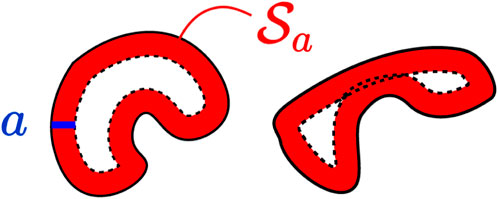
FIGURE 4. Two indicative workspaces (black) and the safety-check set
In (19) to be properly-defined, the parameter a should be set as small as possible, such that: i) there is no ambiguity over which part of the boundary is considered in the distance function (18)—the red regions of Figure 4 should not overlap—and ii) the goal position does not lie within the area
The control law (16) along with (19) can be understood as follows: away from the workspace boundary (outside the set
Remark 2. In order to treat the dynamics discussed in Remark 1 with the additional input multiplier g(p), the optimal input (13)—and its equivalent in (16)—should be altered as follows:
Additionally, the correction term can be enhanced through pre-multiplying with g−1(p)—as a reminder, this concerns the case where g(p) is invertible. Conversely, the technical results in the sequel can be easily extended, however the relevant proofs are omitted for clarity of exposition and readability.
2.3 Technical results
In this section, the asserted technical claims are proven, namely, safety, global asymptotic convergence, and control improvement.
2.3.1 Existence and safety
The feasibility of the correction term (19) necessitates the existence of the projection at the ith iteration13, i.e.,:
To see this, note that through (8) the projection is equal to
Which implies that indeed (23) holds, as the Right-Hand Side (RHS) of (24) is strictly negative
Lemma 1. (Boundedness of the input). Given an admissible policy u(i), the policy u(i+1) is bounded
Proof. It suffices to prove that each term in the sum (16) is bounded. Owing to admissibility of u(i), ∇pV(i) is bounded. Therefore, owing to boundedness of ba(d) the only non-trivial term is
Which, owing to the admissibility of u(i) is bounded ∀p ≠ pd, owing to the denominator being non-zero (as this would imply a local minimum inside the workspace). For p → pd, note that the denominator tends to 0. However, since the term ‖u(i)‖2 converges to zero faster than ‖u(i)‖, the fraction is well-defined and also converges to 0 for p → pd, which concludes the proof.
Lemma 2. (Safety of the input). The control law (16) applied to System (1) results in safe trajectories according to Definition 1 for any initial point
Proof. In order to prove safety, note that owing to the first-order dynamics (1), the safety condition of Definition 1 is equivalent to the velocity of the robot pointing inwards at the boundary, i.e.,
where n(z) is the inwards-pointing vector that is normal to the boundary at the point
Hence, if the ith policy is safe, then
2.3.2 Main technical results
In this subsection, the main technical results are presented in Theorem 1. We prove how (16) results in Global Asymptotic Stability of System (1) through common Lyapunov arguments. A sketch of the proof begins by following the analysis by Abu-Khalaf and Lewis, (2005b) which coincides with our case for any
Additionally, we explore the improvement of the cost function given the sequence of admissible policies (16). Abu-Khalaf and Lewis, (2005b) prove how a successive approximation scheme for nonlinear systems results in policy improvement. However, the workspace boundary in the context of motion planning alters the technical results significantly. We begin by examining the case for the single integrator, in which case the policies are provably improved w.r.t. to the cost function. Subsequently, we show that owing to the general form of the nonlinear term (1) the improvement of the cost function in that case can not be guaranteed for the entire workspace (although it is also not explicitly prohibited). Finally, a brief discussion over the case with drift dynamics is provided.
Theorem 1. (Global Asymptotic Stability and Control Improvement). Given an admissible (see Definition 1) policy u(i) that results in Global Asymptotic Stability of System (1) and the associated cost function V(i) in (2), the policy (16) also results in Global Asymptotic Stability of System (1), which also renders (16) admissible. Furthermore, given the admissible policy
Proof. See Supplementary Appendix S1.
In order to examine the case where
Which yields:
where the parameters in the above equation are omitted for brevity. Therefore, also noting that
we conclude that:
For drift dynamics f(p) that obey (26), the successive application of the proposed policy (16) results in decreasing the cost function. Nonetheless, (26) is not constructive and we can not determine control improvement a-priori. Nevertheless, lack of control improvement over the whole workspace is the price for ensuring safety and convergence. Furthermore, control improvement is guaranteed for trajectories that do not cross
Remark 3. (Global Optimality). In the preceding discussion, it was proven in Theorem 1 that the PI scheme provides a sequence of cost functions of decreasing level sets in the case for the single integrator dynamics, and under (26) for the non-linear case. However, this does not imply that the cost function upon convergence is the globally optimal one, as the sequence might converge to a different (higher) value for some points. Wang and Saridis (1992) have proven that, in a case where the input sequence is given by (15), the cost function upon convergence is nearly globally optimal (in the asymptotic sense)—see Theorem 5 in Wang and Saridis (1992). This holds true for our method as well, for the points where
2.3.3 Cost function computation - Data gathering
The proposed policy (16)–(19) requires the gradient of the cost function and full knowledge of the dynamics. While in RL algorithms unknown dynamics are usually treated, this work is limited to known dynamics, so as not to sacrifice provable guarantees. Nevertheless, treating unknown dynamics is an interesting and well-motivated direction that we intend to explore in the future. Additionally, in contrast to modern RL, where in many cases a Q-function is needed to map the state and policy to the cost, herein we only need to employ the gradient of the cost, as the mapping between the cost function and the optimal policy (w.r.t. the aforementioned instance of the cost function) is available through the HJB Equation 13. Thus, the PI scheme introduced herein suffices to improve upon the previous policies, as long as a representation for the cost function (or its gradient) is available.
In order to compute the cost function, we employ existing theoretical tools from PDE theory. We remind the reader that the relevant PDE consists of Equation 8 with the terminal condition (10), which is explicitly written in the semi-linear form:
where
In order to acquire a solution, the first step is to solve for the characteristic curve of the PDE by solving the first pair of ODEs, namely,
where a characteristic line of the form C = g(x, y) will be obtained. However, note that in (28), the following:
Implies that the characteristic lines are the isochronous curves resulting from implementing the trajectories of (1), which are of the form g(x, y) = t, t ∈ [0, ∞), an example of which is depicted in Figure 5. Note also that (30) admits the solution:
which is related to the preceding sections’ notation through the trajectory
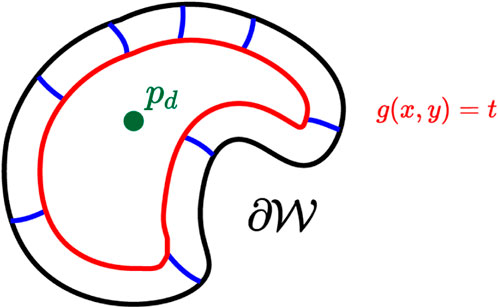
FIGURE 5. The characteristic solution g(x, y) = t (red line). The boundary (black line), the desired position (green disk). Trajectories are also depicted in blue lines linking the boundary to the characteristic.
Finally, the solution of the remaining ODE for the cost function can be obtained:
where the constant
Hence (33) is equivalent to evaluating the cost function for any point
Lemma 3. (Full Coverage of the Workspace). The trajectories (31) of System (1) cover the entire workspace if every initial condition lying on the boundary of the workspace
where
Proof. Let
Which shows that there exist some
2.3.4 Reduction of dimensionality of cost function computation
The above lemma, besides proving equivalence of (33) to (2), for any position inside the workspace, additionally provides a way to reduce the dimensionality of the cost function computation. Normally, to obtain cost function values for any point inside the workspace, the integration of (33) for every such point is necessary. Even if the respective two-dimensional planar workspace was sampled, the complexity would prove intractable as the workspace size grows. However, Lemma 3 shows that it is sufficient to sample over the one-dimensional Jordan curve that forms the boundary of the workspace. This significantly reduces both the complexity and the scaling of the cost function computation. Starting from a discrete set of initial positions
With the initial conditions x(0), y(0), vu(0) = 0 whose solution yields the cost function (2), evaluated over points that lie on the computed trajectories of System (1):
where a dummy function vu was employed to compute the cost function. Eq. 37 is essentially identical to (33), evaluated over the trajectories of System (1). In summary, the data gathered over the trajectories through the solution of (27) consist of tuples of the robot’s position, along with the corresponding cost values, i.e.,
Note that the above process yields the value of the cost function of an admissible policy at a collection of collocation points. However, this collection cannot be readily employed to extract a policy, as the gradient of the cost function is explicitly required for providing a control input. While numerical differentiation could provide a discrete form of the latter, in the sequel we propose a method to provide a continuous representation of the cost function gradient through DNNs. This approach is similar in scope to (Abu-Khalaf and Lewis, 2005a), where the optimal cost function is iteratively approximated.
2.4 The proposed PI scheme
In this section, the preceding elements are combined in a complete framework in the form of an algorithm. We also provide details regarding the implementation of our method in the following subsections.
2.4.1 Algorithm
Algorithm 1 provides an overview of the proposed PI scheme. This relatively simple algorithm results in policies that inherit the traits discussed in Section 2.3, and thus yields almost optimal admissible policies. Briefly, Algorithm 1 starts with obtaining the simply-connected workspace transformation, in a case where obstacles are present. Then, a number of samples are taken over the boundary, and trajectories are run for the initial policy in order to gather cost data. The cost data are then numerically differentiated and the cost function’s normalized gradient is approximated through a DNN. The policy is finally updated, and the whole scheme is repeated until convergence. Some further details are discussed in the following Subsections.
Algorithm 1.PI ALGORITHM.
• Given a Workspace
if
else
end if
• Take
• Starting from an initial policy
Set i ← 0
Set converged ←False
while not(converged) do
• Compute Cost: V(i) through running trajectories (36) from the initial states
• Differentiate the cost numerically,
• Approximate the Cost Function’s Normalized Gradient with a feed-forward NN,
• Update the next policy u(i+1) through (16),
if i > 0 then
if ‖∇pV(i+1) − ∇pV(i)‖ ≤ E then
converged ←True
end if
end if
• i ← i + 1
end while
• Upon convergence i = I the optimal policy is: u⋆ ≈ u(I)
2.4.2 Normalized gradient approximation
In order to implement (16) the gradient of the cost of the previous policy is required. In Deep RL, usually the cost function is approximated through a DNN from data gathered through trajectories. Note that in Algorithm 1 such a data-gathering process is included. Therefore, a DNN will also be employed in this case. However, since, owing to the deterministic and model-based scheme that is proposed, the relationship between the policy and the cost is explicit through (12) and (13), the gradient of the cost function can be employed directly. Still, as can be seen in Eq. 2, obtaining the value for the cost function for a given point inside the workspace requires integrating the trajectory of the robot from the latter unil convergence. While this method can be employed for obtaining a singular value, note that the control laws for the PI method in Eq. 16 require the cost function gradient explicitly, which is not available. Therefore, in order to approximate the gradient, and having obtained values for the surface of the cost function (2) at discrete points
where
Therefore, we can normalize the gradient and approximate the direction of the field. The field is normalized as follows:
where ϵ is a small, positive constant. If the exact normalization was employed instead of (40), i.e.,
In summary, two DNNs are employed15, one for each component of the normalized gradient. Subsequently, the norm of the gradient can be computed through (39). The effect of the normalization is to alleviate approximation issues over the workspace, as the training data exhibit significantly less variation, as well as negate the need for a heuristic for weighting the error vector during the training process. In practice, this step produced significantly better and more consistent results than approximating the gradient of the cost or the cost itself, requiring minimal tuning (namely, the DNN layer characteristics) over a variety of workspaces.
2.4.3 Parallel integration scheme
Another significant implementation detail is the parallelizable computation of the trajectories of system (36). Note that each trajectory stemming from an initial point at the boundary can be computed independently. We therefore employ the GPU capabilities of modern machines in order to perform the relevant computation in parallel through a custom parallelized integration scheme, which significantly improves the performance of our method, as it will be presented in the results’ section.
2.5 An atlas for alleviating computation in large workspaces
While the proposed method provides several desirable traits owing to the technical results of Section 2.3, it results in expensive computations. In this section, we propose a scheme for alleviating the computational load and the scaling properties of the method, especially when considering large workspaces. This is heavily inspired by Vlantis et al. (2018a) where an atlas of harmonic maps is employed to improve the computational characteristics of the proposed method.
Consider an atlas
where
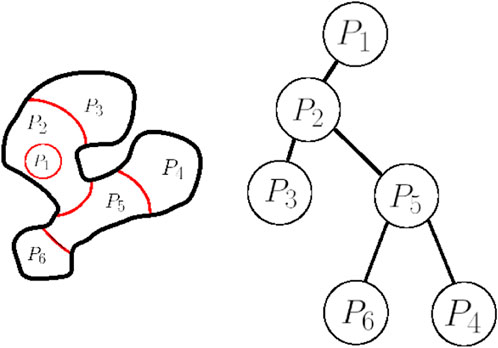
FIGURE 6. The workspace (left) with its boundary depicted in black lines, and the curves that partition the workspace depicted in red. The corresponding tree is depicted on the right.
We employ the above tree-decomposition in order to ameliorate the computational performance of the proposed PI scheme, in the following way. Let
where
And
This further parallelization of the computation of trajectories significantly speeds up the process in large workspaces and it can readily be incorporated with the technical results of Section 2.3.4 to provide a more efficient training scheme, as will become apparent in the results’ section.
3 Results
In this section, we demonstrate the validity of the proposed scheme and our technical results, as well as the applicability of our method. We present various workspaces, from the example of a π-shaped obstacle as an initial demonstration (transformed into a simply-connected version as discussed in Section 2.2.3), along with more complex maze workspaces. A case for non-linear dynamics is also presented. Furthermore, comparative studies are provided. All results were implemented with MATLAB, version 2021b, running on a PC with an Intel-i7 quad-core processor, with an NVIDIA Geforce GTX-1060 GPU. For all of the presented results (excluding the case of Figure 7) the weighting parameters α, β were set equal to 1. The distance parameter was chosen as a = 0.1 for the π-shaped obstacle workspace and as a = 0.3 for the maze workspaces. Finally, the employed DNN consists of 3 layers, with sizes
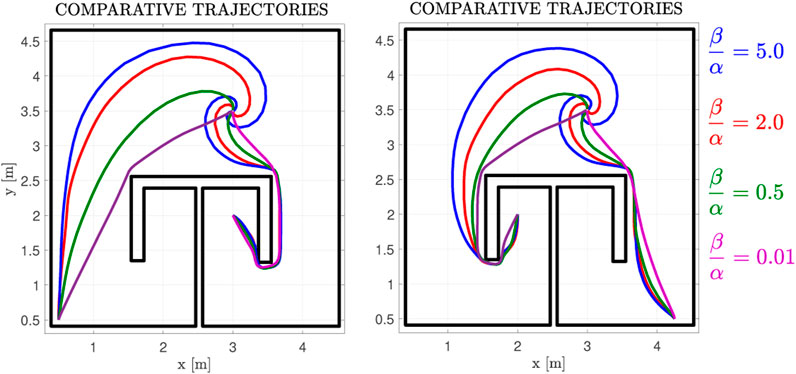
FIGURE 7. Exemplary Trajectories for a parameter sweep of the input-related cost weight β over the state-related cost weight α, for the case of the non-linear drift dynamics depicted in Figure 11.
3.1 Proposed method results
3.1.1 Single integrator dynamics
First of all, we demonstrate the validity of our method through a simple example of a square workspace with an internal, π-shaped obstacle. The initial and simply-connected versions of the workspace are depicted in Figure 2. The comparative cost functions for the initial and final policies are depicted in Figure 8, along with the initial and final (normalized) vector fields, and exemplary trajectories. The improvement of the cost is significant, with the trajectories exhibiting almost optimal path length. We further demonstrate our approach in a more complex environment, the results of which are depicted in Figure 9. The efficacy of the proposed method in decreasing the cost is again demonstrable. We also present “snapshots” of the velocity field for a simple workspace where the effectiveness of the method is apparent in Figure 10. Notably, even after the first iteration of the algorithm, the field already exhibits close to optimal behaviour, which demonstrates the fast convergence of PI methods.

FIGURE 8. Results for the π-shaped workspace, for the case of zero non-linear dynamics. The initial and final cost functions are presented in logarithmic scale (first and third subfigures), along with the respective (normalized) vector fields in blue arrows (second and fourth subfigures). Some exemplary trajectories are also depicted in red lines, with the goal position depicted with a green disk.
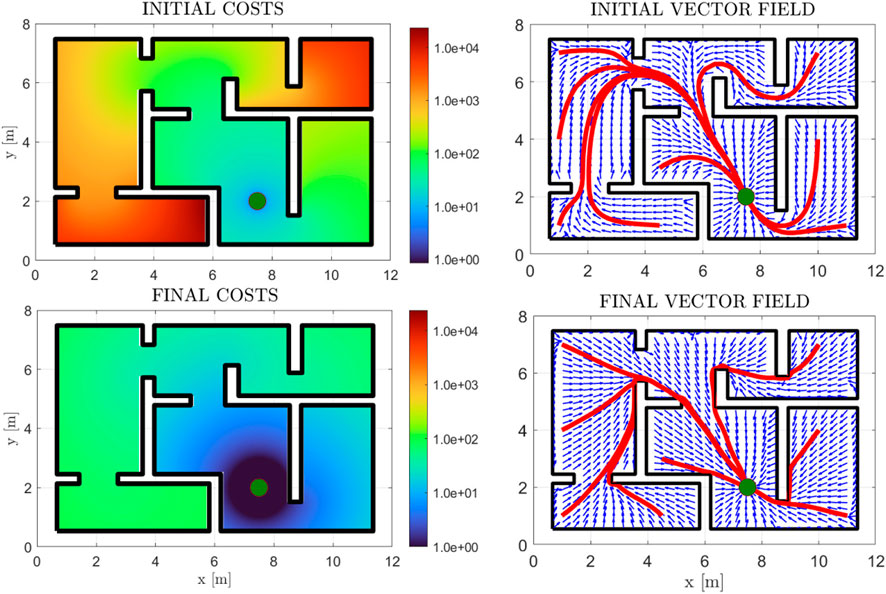
FIGURE 9. Initial and Final Costs for a maze workspace, in logarithmic scale (left subfigure column). The initial and final normalized vector fields are depicted (blue arrows) (right subfigure column), along with some trajectories (red) and the goal position (green disk).

FIGURE 10. The resulting Vector Fields at different steps of the PI scheme. The normalized velocity field is depicted in blue and the workspace boundary is depicted in black.
3.1.2 Nonlinear drift dynamics
In this subsection, we present a case where the drift dynamics are non-zero. We consider the case of rotational dynamics with the distance-to-the-goal norm:
The normalized dynamics, along with the initial cost function, the final velocity field, and its respective cost are depicted in Figure 11. The initial velocity field is not depicted in this case, as per Eq. 6, it is identical with the one in Figure 8. We note that the costs for the linear and non-linear cases are different, owing to the drift term f(p). Concerning the final policy of Figure 8 (linear case) the cost of points on the left side behind the π obstacle is higher than those on the right side, owing to them being farther away from the goal position. On the contrary, in Figure 11 (non-linear case), the drift term on the left side points towards a direction that “helps” the robot expend less energy, whereas in the right side, the robot has to “overcome” the flow of the drift term to safely navigate towards the goal. This results in the farthest away region behind the obstacle admitting lower cost values. Additionally, in Figure 7, we investigate how trajectories are altered for various ratios β/α. It is clear that, as the ratio increases, the input-related cost term dominates (2) and thus the algorithm “prioritizes” conserving input energy over converging quickly to the goal. Therefore, the trajectories converge to the goal position slower, while also being “carried along” by the drift dynamics, which results in the spiralling trajectories depicted in Figure 7.

FIGURE 11. Results for the π-shaped workspace, for the case of a rotational vector field for non-linear drift dynamics (left-most plot). The initial and final cost functions are presented in logarithmic scale (second and third subfigures), along with the final (normalized) velocity field in blue arrows (fourth subfigure). Some exemplary trajectories are also depicted in red lines, with the goal position depicted with a green disk.
3.1.3 Workspace decomposition
In this subsection, we present the application of the workspace decomposition scheme of Section 2.5. We demonstrate the similarity of the cost functions, along with the employed decomposition and the efficacy of the parallelized scheme in decreasing the computational time of each iteration in Figure 12. The 10% error between the original method and the decomposition scheme (although minimal) can be attributed to the accumulation of the cost function gradient approximation error over the boundaries of the workspace subdivisions. This hypothesis is in accordance with Figure 12, where the error is observed over the remotest subdivision w.r.t. the goal position, where the accumulation of the aforementioned error is expected to have the most impact.

FIGURE 12. Final Cost Function Comparison with (first subfigure) and w/o (second subfigure) the Decomposition Scheme 2.5. The final cost functions exhibit essentially the same form with a +10% increase at the maximal value. The computational gain is demonstrated in the right-most figure, where the original method’s execution times are depicted in black, while the decomposition scheme’s times are depicted in red. The employed decomposition is also depicted through the shaded regions in the top right corner.
3.2 Comparative results
3.2.1 Comparison with continuous methods
In order to evaluate the performance of our method, approaches with similar scope and results should be employed. Since the proposed method concentrates on the formal solution of the high-level reactive optimal MP problem (in the form of a velocity vector field), a comparison against the plethora of existing platform-specific DRL approaches would not provide any meaningful comparisons. Therefore, we initially compare the cost function (2) produced by our method against two previous harmonic-based approaches. The results for the reactive, AHPF methods are presented in Figure 13. In the left-most figure, the method by Rousseas et al. (2020) was implemented, where the weights of an AHPF assume a state-feedback form. In the central figure, we present a custom method where a constrained-optimization RL strategy is employed to extract the optimal constant AHPF weights. Our method’s cost function is presented again for completeness. It is clear that, although the method by Rousseas et al. (2020) provides descent results, significantly better than the constant weights case, the herein proposed method exhibits a significant overall improvement.
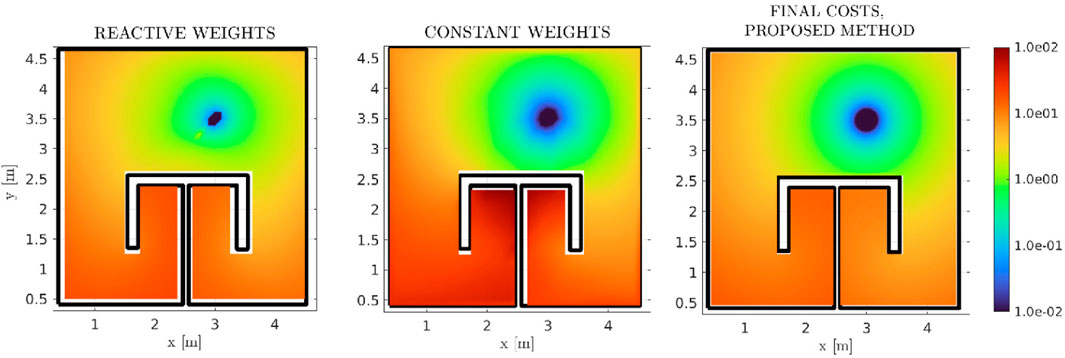
FIGURE 13. Comparative Final Cost functions between three reactive methods, namely (Rousseas et al., 2020) in logarithmic scale, where the AHPF weights are non-constant functions of the position (first subfigure), a custom, in-house RL scheme which computes the optimal (constant) AHPF weights (second subfigure), and the proposed method respectively (third subfigure). Our method outperforms both previous ones. While it is not self-evident due to the depicted range, the proposed method assumes a maximal value of
3.2.2 Comparison with sampling-based methods
Subsequently, we employ the length of the produced trajectories, as a metric to compare against two approaches, an RRT⋆ and a PRM one. RRT⋆ serves as a baseline to evaluate the optimality of our method, as it produces asymptotically optimal results, while PRMs also provide a fair comparison. Nonetheless, note that, even though path length is a valid metric for these methods, the cost function (2) can not be directly evaluated, as they only produce feasible paths and not inputs. In previous works (Rousseas et al., 2020; Rousseas et al., 2021; Rousseas et al., 2022), we have employed RRT⋆ planners that include input-space sampling. However, due to sampling over a 4D space, the RRT⋆ results presented therein do not consist of fair evaluations against the current method. Nevertheless, we are able to asses the performance of our method even more strictly, as the on-trajectory optimal velocity norm can be computed analytically for any trajectory. More specifically, consider the HJB equation (for the single integrator case):
where
Therefore, this norm can be applied over the RRT⋆/PRM-obtained trajectories to evaluate the global optimality of our method. Note however, that due to the nature of SBMs, the above globally optimal solution produces discontinuous velocity vectors along non-smooth paths, as the latter consist of quasi-linear segments.
We therefore present some exemplary trajectories for the workspace with the π-shaped obstacle (against RRT⋆), as well as for one of the previously presented complex workspace of Figure 9 (for both sampling-based methods). The results are summed up in Tables 1 and 2. In both cases, 50 trials were carried out to achieve statistical significance for the SBMs. Notably, we conclude that our method exhibits mostly reduced or identical path lengths to the SBM’s ones. Taking into account that, first of all, in our method the field’s norm and direction were concurrently optimized, along with the fact that our method produces a continuous field over the whole workspace (in contrast to the RRT⋆’s single, non-smooth trajectories), our method can be considered successful in providing globally optimal solutions in the herein presented examples w.r.t. path length.
Concerning the cost function (2), in Tables 1 and 2 we present comparative cost function values for the π-obstacle and complex maze workspaces. Our method produces mostly reduced cost function values compared to the best results from the SBMs, with few exceptions where the cost is nevertheless closely matched. Most importantly, comparing with the median or mean values of these methods, our method is consistently superior. Notably, as the initial position is placed farther from the goal position, our method produces significantly better results, as demonstrated in Table 2. Since our method produces similar or improved path lengths, compared to two SBMs, while also outperforming the latter when the analytically computed optimal velocity norm was applied, we conclude that our method produces close to the globally optimal navigation vector field in the herein presented results. We furthermore note that upon convergence, the velocity norm produced by our method is indeed the optimal one described in (46), as scaling the field appropriately did not alter the results.
Finally, we compare the proposed method for the case of nonlinear dynamics depicted in Figure 11. In Table 3, the cost function values are shown for 10 trials of the SST⋆ method (Li et al., 2016) for the six initial points of Figure 11. Non parametric statistical values—minimum, median, maximum values—as well as the mean values are depicted. Our method outperforms the latter by a large margin. This is most likely due to the method being able to plan most effectively for dynamics that are not position-dependent (such as unicycle models, Dubins car, etc.) in contrast to the challenging case of position-dependent dynamics, where the SBM is not able to plan a highly optimal tree, producing highly jagged paths. This effect demonstrates the advantages of reactive global planning, where the approach is able to extract a close-to-optimal cost function. Finally, the proposed method is continuous and thus guarantees the applicability of the approach, whereas the SST⋆ method performs numerical integration for computing the cost-to-go as well as ensuring safety, which might introduce instabilities or safety violations in practice, in some cases.
3.3 Gazebo simulation results
In order to demonstrate the applicability of the proposed scheme, the herein proposed method was employed in a realistic, high-fidelity simulation environment, through the Gazebo (Koenig and Howard, 2004) simulation environment. A simple maze environment was constructed, and the Kuka YouBot (Bischoff et al., 2011) holonomic robot was chosen as the mobile platform, owing to its omni-directional wheels18. The workspace’s boundary was augmented during the optimization process so as to account for the robot’s dimensions. The robot is equipped with the Robot Operating System (ROS) (Quigley et al., 2009), and the proposed controller was implemented in MATLAB. Communication between MATLAB and ROS was established through the ROS Toolbox. Since the method is off-line and in the context of known-workspaces, the robot’s odometry, with no additional localization, was employed. Even through the position estimate is not highly accurate, owing to the reactive nature of the proposed scheme, planning proved to be robust enough to always prove successful in this challenging condition. It is evident that a more accurate position estimate (such as with SLAM) would only improve our method’s performance in realistic conditions.
The synthetic workspace, along with the YouBot model, are depicted in Figure 14. The resulting trajectories for four starting configurations, along with the evolution of the on-trajectory cost function (2), are depicted in Figure 15, along with the normalized velocity vector field, for a single final desired position. The cost function parameters were set as α = 1.0 and β = 40, in order for the robot to move at a “realistic” speed towards the goal (we remind the reader that these parameters are chosen according to design specifications). As can be evidenced by the convergence of the cost function in Figure 15, the robot converged to the final position at approximately 25[s] max. A video of the simulation is available through the hyperlink: https://vimeo.com/794492675.
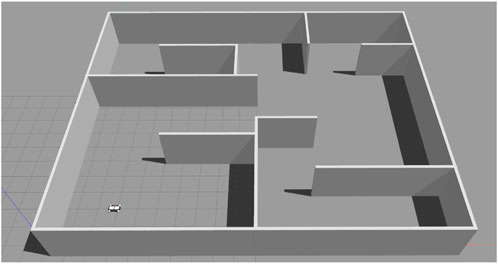
FIGURE 14. The robot’s workspace in the Gazebo simulation environment, along with the YouBot holonomic robot model.
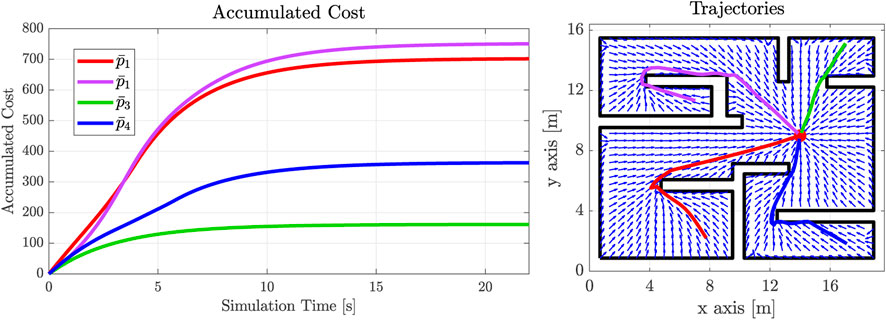
FIGURE 15. Accumulated on-trajectory cost (left figure) along with the workspace (black line) and four trajectories (right figure). The normalized velocity field is also depicted through blue arrows. The final goal position is placed at [14,9]T.
4 Discussion
It has been demonstrated, through the aforementioned results, that the proposed method successfully tackles the reactive optimal MP problem. The trajectories demonstrate close to globally optimal behaviour, with advantageous path length and velocity profile. Notably, while the metric (2) does not optimize for the path length directly, we have shown how our method produces nearly optimal path lengths. Notice that the faster way to converge to the desired position with minimal energy expenditure is indeed to follow the minimum-length path while furthermore applying the minimum possible velocity (which depends on the ratio
With regards to execution times, our method took 6.5 min s and 209 min s for the workspaces of Figures 8, 9 respectively, without the workspace decomposition scheme of Section 2.5. For Figure 12, where the workspace decomposition scheme was employed, the algorithm took 33 min s to converge. In comparison, for the exemplary trajectories for 50 trials of the RRT⋆ method, the execution times were 7 min s (1.5 s per trajectory) and 70.4 min s (10.6 s per trajectory) for Figures 8, 9 respectively. The total time for all trajectories was calculated in order to provide a fair comparison due to the following reasons: 1) the 50 trials resulted in the non-parametric statistical results of Tables 1 and 2, therefore, running fewer trajectories would not necessarily yield the minimum values depicted therein, 2) as our method produces results for any initial position, several RRT⋆ trajectories are employed to cover the whole workspace (even though we would like to point out that 8 trajectories are still not sufficient for full workspace coverage). Obtaining additional trajectories through the RRT⋆ method would require re-running the latter. Our approach, owing to the reactive formulation, provides a reactive solution for any starting configuration. A different way to view the above comparison rests on treating the total 400 starting-ending SBM positions as being spread out over the entire workspace, thus resulting in quasi-similar global navigation as in the case of continuous methods. If spread out uniformly over a rectangle of dimensions 11 × 7 [m]2 (which covers an area of approximately 77[m]2), the 400 trajectories yield a distribution of approximately 5.2 initial positions per [m]2. Hence, the initial points would be distributed with a resolution of 2.2 points per meter for each dimension, which is a reasonable coverage for practical applications. Nevertheless, this would emphatically not yield results as satisfactory as those depicted in Table 2, as the above analysis implies one single trajectory per initial point. Nevertheless, SBMs still prove faster in cases where only a single trajectory is required.
While the method proposed in this work exhibits some very promising results, several limitations persist. The main one relates to the curse of dimensionality that plagues PI-related methods, where exhaustive sampling is needed. Indeed, as the number of dimensions grows, the complexity of both the data-gathering and the cost function approximation steps would scale exponentially. Future research efforts will concentrate on ameliorating this aspect of the algorithm, with possible extensions including approximate guaranteed solutions (Jiang et al., 2016) and/or Off-Policy formulations.
Additionally, we intend to extend our work to more complicated state-spaces such as considering orientations and higher-order dynamics. Finally, the computational aspect of our work can be ameliorated.
4.1 Future work
We intend to expand the scope of the results in two main ways. First of all, we aim to provide a solution that optimizes the field for any final desired position, in contrast to the present method, where a solution is obtained for a single goal position. Another important aspect is treating unknown robot dynamics with provable guarantees. We further posit that this framework can be easily extended to consider saturated inputs, which would significantly enhance the applicability of the method, as the current formulation necessitates large inputs. Additionally, the framework could be extended for second-order mechanical systems, which would cover a variety of robotic platforms. Finally, the most important future direction that we intend to pursue is to address the existence of obstacles.
Data availability statement
The original contributions presented in the study are included in the article/Supplementary Material, further inquiries can be directed to the corresponding author.
Author contributions
PR: Conceptualization, Formal Analysis, Funding acquisition, Investigation, Methodology, Software, Validation, Visualization, Writing–original draft. CB: Conceptualization, Funding acquisition, Supervision, Writing–review and editing. KK: Funding acquisition, Project administration, Supervision, Writing–review and editing.
Funding
The author(s) declare financial support was received for the research, authorship, and/or publication of this article. The research work was supported by the Hellenic Foundation for Research and Innovation (HFRI) under the fourth Call for HFRI PhD Fellowships (Fellowship Number: 9110).
Acknowledgments
We would like to thank the undergraduate student Marios Malliaropoulos of the School of Mechanical Engineering NTUA and the PhD candidate Christos Vlachos, of the Department of Electrical and Computer Engineering of the University of Patras, for providing the comparative reactive policy results of Figure 13 and Section 3.
Conflict of interest
The authors declare that the research was conducted in the absence of any commercial or financial relationships that could be construed as a potential conflict of interest.
The handling editor PT declared a past co-authorship with the author KK.
Publisher’s note
All claims expressed in this article are solely those of the authors and do not necessarily represent those of their affiliated organizations, or those of the publisher, the editors and the reviewers. Any product that may be evaluated in this article, or claim that may be made by its manufacturer, is not guaranteed or endorsed by the publisher.
Supplementary material
The Supplementary Material for this article can be found online at: https://www.frontiersin.org/articles/10.3389/frobt.2023.1255696/full#supplementary-material
Footnotes
1A disk robot can also be considered by applying a workspace transformation that inflates the workspace boundaries:
2While in the following Results section we have provided examples of polygonal workspaces, the proposed method can also be employed for smooth boundaries.
3This definition ensures that under the control law u the robot does not collide with the workspace boundary at any point along all trajectories (for any initial position
4Non-reactive methods are unsuitable due to cost function non-smoothness.
5Note that in case where the drift term is zero, the velocity v(p) and the input u(p) are identical.
6Even though the method by Rousseas et al. (2022) is employed in the context of unknown workspaces, the framework can be trivially extended to fully known ones by considering the entire boundary as having been sensed by the robot’s sensors.
7Note that nothing prohibits the vector field v exhibiting saddle points exactly at the boundary
8The term “stable” relates to stability w.r.t. the equilibrium point, not the goal position.
9Note that, by construction, the vector field (5) has a sink at pd, therefore the case where
10If we assume the opposite, then either the goal is not a global minimum of the field, or the field is not safe at the boundary, leading to a contradiction.
11Successive Approximation as employed by Abu-Khalaf M. and Lewis FL. (2005) can be understood to be a PI scheme.
12The use of the English letter a here is not to be mistaken for the Greek letter α in (3a).
13If the projection were indeed equal to zero, then by the definition of the correction term (19), the robot’s velocity would assume a zero-value, thus leading to lack of convergence.
14In a few words, we formally approximate two 2-dimensional discontinuous manifolds embedded in
15While a single, two-output DNN can also be employed, in practice we found that it resulted in poorer approximation of the normalized gradient.
16The choice of a subdivision according to contours of the cost function is not unique, as topologically homeomorphic 2-dimensional curves can also be considered. The complement set of each subdivision however (i.e.,
17The parent/child relationship is independent of which trajectory starting in any subset Pk is considered, as all trajectories can be shown to exit Pk by crossing the curve
18The proposed scheme can also be applied for non-holonomic platforms, owing to the reactive velocity field, through employing a low-level tracking controller.
19
References
Abu-Khalaf, M., and Lewis, F. (2005a). Nearly optimal control laws for nonlinear systems with saturating actuators using a neural network hjb approach. Automatica 41, 779–791. doi:10.1016/j.automatica.2004.11.034
Abu-Khalaf, M., and Lewis, F. L. (2005b). Nearly optimal control laws for nonlinear systems with saturating actuators using a neural network hjb approach. Automatica 41 (5), 779–791. doi:10.1016/j.automatica.2004.11.034
Amiryan, J., and Jamzad, M. (2015). “Adaptive motion planning with artificial potential fields using a prior path,” in 3rd RSI International Conference on Robotics and Mechatronics. pp. 731–736. doi:10.1109/ICRoM.2015.7367873
Anastopoulos, N., Nikas, K., Goumas, G., and Koziris, N. (2009). “Early experiences on accelerating dijkstra’s algorithm using transactional memory,” in Proceedings of the 2009 IEEE International Parallel and Distributed Processing Symposium.
Beard, R., Saridis, G., and Wen, J. (1995). “An iterative solution to the finite-time linear quadratic optimal feedback control problem,” in Proceedings of 1995 American Control Conference - ACC’95, 3921–3922. doi:10.1109/ACC.1995.533878
Bechlioulis, C. P., and Rovithakis, G. A. (2008). Robust adaptive control of feedback linearizable mimo nonlinear systems with prescribed performance. IEEE Trans. Automatic Control 53 (9), 2090–2099. doi:10.1109/TAC.2008.929402
Bischoff, R., Huggenberger, U., and Prassler, E. (2011). “Kuka youbot - a mobile manipulator for research and education,” in 2011 IEEE International Conference on Robotics and Automation, 1–4. doi:10.1109/ICRA.2011.5980575
Bozkurt, D., Ali, D., and Şengül, T. (2020). Interior structural bifurcation of 2D symmetric incompressible flows. Discrete Continuous Dyn. Syst. - B 25, 2775–2791. doi:10.3934/dcdsb.2020032
Brunton, S. L., and Kutz, J. N. (2021). Data-driven science and engineering: machine learning, dynamical systems, and control. Cambridge University Press. doi:10.1017/9781108380690
Devo, A., Mezzetti, G., Costante, G., Fravolini, M. L., and Valigi, P. (2020). Towards generalization in target-driven visual navigation by using deep reinforcement learning. IEEE Trans. Robotics 36 (5), 1546–1561. doi:10.1109/TRO.2020.2994002
Francis, A., Faust, A., Chiang, H. T. L., Hsu, J., Kew, J. C., Fiser, M., et al. (2020). Long-range indoor navigation with prm-rl. (arXiv Preprint).
Freeman, R. A., and Kokotovic, P. V. (1996). Inverse optimality in robust stabilization. SIAM J. Control Optim. 34 (4), 1365–1391. doi:10.1137/S0363012993258732
Geraerts, R., and Overmars, M. H. (2007). Creating high-quality paths for motion planning. Int. J. Robotics Res. 26 (8), 845–863. doi:10.1177/0278364907079280
Grandia, R., Jenelten, F., Yang, S., Farshidian, F., and Hutter, M. (2022). Perceptive locomotion through nonlinear model predictive control. doi:10.48550/ARXIV.2208.08373
Horowitz, M. B., and Burdick, J. W. (2014). “Optimal navigation functions for nonlinear stochastic systems,” in IEEE/RSJ International Conference on Intelligent Robots and Systems, 224–231. doi:10.1109/IROS.2014.6942565
Inoue, M., Yamashita, T., and Nishida, T. (2019). “Robot path planning by lstm network under changing environment,” in Advances in computer communication and computational sciences (Springer), 317–329.
Jaillet, L., Cortes, J., and Simeon, T. (2008). “Transition-based rrt for path planning in continuous cost spaces,” in IEEE/RSJ International Conference on Intelligent Robots and Systems, 2145–2150. doi:10.1109/IROS.2008.4650993
Jiang, F. J., Chou, G., Chen, M., and Tomlin, C. J. (2016). Using neural networks to compute approximate and guaranteed feasible Hamilton-Jacobi-bellman pde solutions. (arXiv Preprint).
Karaman, S., and Frazzoli, E. (2011). Sampling-based algorithms for optimal motion planning. Int. J. Robotics Res. 30 (7), 846–894. doi:10.1177/0278364911406761
Kavraki, L., Svestka, P., Latombe, J. C., and Overmars, M. (1996). Probabilistic roadmaps for path planning in high-dimensional configuration spaces. IEEE Trans. Robotics Automation 12 (4), 566–580. doi:10.1109/70.508439
Kim, J., and Khosla, P. (1991). “Real-time obstacle avoidance using harmonic potential functions,” in IEEE International Conference on Robotics and Automation. IEEE Computer Society, 790–796. doi:10.1109/ROBOT.1991.131683
Koditschek, D. E., and Rimon, E. (1990). Robot navigation functions on manifolds with boundary. Adv. Appl. Math. 11 (4), 412–442. doi:10.1016/0196-8858(90)90017-S
Koenig, N., and Howard, A. (2004). “Design and use paradigms for gazebo, an open-source multi-robot simulator,” in 2004 IEEE/RSJ International Conference on Intelligent Robots and Systems (IROS) IEEE Cat. No.04CH37566), 3, 2149–2154. doi:10.1109/IROS.2004.1389727
Koenig, S., and Likhachev, M. (2002). “D*lite,” in Proceedings of the National Conference on Artificial Intelligence, 476–483.
Latombe, J. C. (1999). Motion planning: a journey of robots, molecules, digital actors, and other artifacts. Int. J. Robotics Res. 18 (11), 1119–1128. doi:10.1177/02783649922067753
LaValle, S. M., James, J., and Kuffner, J. (2001). Randomized kinodynamic planning. Int. J. Robotics Res. 20 (5), 378–400. doi:10.1177/02783640122067453
Lei, X., Zhang, Z., and Dong, P. (2018). Dynamic path planning of unknown environment based on deep reinforcement learning. J. Robotics 1, 1–10. doi:10.1155/2018/5781591
Li, Y., Littlefield, Z., and Bekris, K. (2016). Asymptotically optimal sampling-based kinodynamic planning. Int. J. Robotics Res. 35 (5), 528–564. doi:10.1177/0278364915614386
Loizou, S. (2011). Closed form navigation functions based on harmonic potentials, 6361–6366. 978-1-61284-800-6. doi:10.1109/CDC.2011.6161438
Loizou, S. G., and Rimon, E. D. (2021). Correct-by-Construction navigation functions with application to sensor based robot navigation. arXiv 2103. doi:10.48550/arXiv.2103.04445
Mattamala, M., Chebrolu, N., and Fallon, M. (2022). An efficient locally reactive controller for safe navigation in visual teach and repeat missions. IEEE Robotics Automation Lett. 7 (2), 2353–2360. doi:10.1109/LRA.2022.3143196
Miki, T., Lee, J., Hwangbo, J., Wellhausen, L., Koltun, V., and Hutter, M. (2022). Learning robust perceptive locomotion for quadrupedal robots in the wild. Sci. Robotics 7 (62), eabk2822. doi:10.1126/scirobotics.abk2822
Mohamed, I. S., Allibert, G., and Martinet, P. (2020). “Model predictive path integral control framework for partially observable navigation: a quadrotor case study,” in 2020 16th International Conference on Control, Automation, Robotics and Vision (ICARCV), 196–203. doi:10.1109/ICARCV50220.2020.9305363
Nandakumaran, A. K., and Datti, P. S. (2020). First-order partial differential equations: method of characteristics. Cambridge University Press, 48–86. chapter 3. Cambridge IISc Series. doi:10.1017/9781108839808.004
Paxton, C., Raman, V., Hager, G. D., and Kobilarov, M. (2017). “Combining neural networks and tree search for task and motion planning in challenging environments,” in IEEE/RSJ International Conference on Intelligent Robots and Systems, 6059–6066. doi:10.1109/IROS.2017.8206505
Pearl, J. (1984). “Heuristics - intelligent search strategies for computer problem solving,” in Addison-wesley series in artificial intelligence.
Quigley, M., Gerkey, B., Conley, k, Faust, J., Foote, T., Leibs, J., et al. (2009). “Ros: an open-source robot operating system,” in ICRA workshop on open source software, 5, Japan: Kobe.
Rimon, E., and Koditschek, D. (1992). Exact robot navigation using artificial potential functions. IEEE Trans. Robotics Automation 8 (5), 501–518. doi:10.1109/70.163777
Rousseas, P., Bechlioulis, C., and Kyriakopoulos, K. (2024). Harmonic-based optimal motion planning in constrained workspaces using reinforcement learning. IEEE Robotics Automation Lett. 6 (2), 2005–2011. doi:10.1109/LRA.2021.3060711
Rousseas, P., Bechlioulis, C. P., and Kyriakopoulos, K. J. (2020). “Optimal robot motion planning in constrained workspaces using reinforcement learning,” in 2020 IEEE/RSJ International Conference on Intelligent Robots and Systems (IROS), 6917–6922. doi:10.1109/IROS45743.2020.9341148
Rousseas, P., Bechlioulis, C. P., and Kyriakopoulos, K. J. (2022). Trajectory planning in unknown 2d workspaces: a smooth, reactive, harmonics-based approach. IEEE Robotics Automation Lett. 7 (2), 1992–1999. doi:10.1109/LRA.2022.3143308
Roy, N., Posner, I., Barfoot, T., Beaudoin, P., Bengio, Y., Bohg, J., et al. (2021). From machine learning to robotics: challenges and opportunities for embodied intelligence.
Sertac, K., and Emilio, F. (2011). Sampling-based algorithms for optimal motion planning. Int. J. Robotics Res. 30, 846–894. doi:10.1177/0278364911406761
Vadakkepat, P., Tan, K. C., and Ming-Liang, W. (2000). “Evolutionary artificial potential fields and their application in real time robot path planning,” in Proceedings of the 2000 Congress on Evolutionary Computation (CEC00), 256–263. doi:10.1109/CEC.2000.870304
Vlantis, P., Vrohidis, C., Bechlioulis, C. P., and Kyriakopoulos, K. J. (2018a). “Robot navigation in complex workspaces using harmonic maps,” in IEEE International Conference on Robotics and Automation (ICRA), 1726–1731. doi:10.1109/ICRA.2018.8460695
Vlantis, P., Vrohidis, C., Bechlioulis, C. P., and Kyriakopoulos, K. J. (2018b). “Robot navigation in complex workspaces using harmonic maps,” in 2018 IEEE International Conference on Robotics and Automation (ICRA), 1726–1731. doi:10.1109/ICRA.2018.8460695
Waelbroeck, L. (1967). Some theorems about bounded structures. J. Funct. Analysis 1, 392–408. doi:10.1016/0022-1236(67)90009-2
Wang, F. Y., and Saridis, G. (1992). “Suboptimal control for nonlinear stochastic systems,” in [1992] Proceedings of the 31st IEEE Conference on Decision and Control, 1856–1861. doi:10.1109/CDC.1992.3711092
Wang, J., Meng, M. Q. H., and Khatib, O. (2020a). Eb-rrt: optimal motion planning for mobile robots. IEEE Trans. Automation Sci. Eng. 17 (4), 2063–2073. doi:10.1109/TASE.2020.2987397
Wang, Z., Li, Y., Zhang, H., Liu, C., and Chen, Q. (2020b). Sampling-based optimal motion planning with smart exploration and exploitation. IEEE/ASME Trans. Mechatronics 25 (5), 2376–2386. doi:10.1109/TMECH.2020.2973327
Weston, J., and Watkins, C. (1999). Support vector machines for multi-class pattern recognition, 219–224.
Williams, G., Aldrich, A., and Theodorou, E. A. (2017). Model predictive path integral control: from theory to parallel computation. J. Guid. Control, Dyn. 40 (2), 344–357. doi:10.2514/1.G001921
Keywords: optimal motion planning, optimal control, reinforcement learning, nonlinear systems and control, path planning
Citation: Rousseas P, Bechlioulis C and Kyriakopoulos K (2024) Reactive optimal motion planning for a class of holonomic planar agents using reinforcement learning with provable guarantees. Front. Robot. AI 10:1255696. doi: 10.3389/frobt.2023.1255696
Received: 09 July 2023; Accepted: 20 October 2023;
Published: 03 January 2024.
Edited by:
Panagiotis Tsiotras, Georgia Institute of Technology, United StatesReviewed by:
Robert Penicka, Czech Technical University in Prague, CzechiaSavvas Loizou, Cyprus University of Technology, Cyprus
Copyright © 2024 Rousseas, Bechlioulis and Kyriakopoulos. This is an open-access article distributed under the terms of the Creative Commons Attribution License (CC BY). The use, distribution or reproduction in other forums is permitted, provided the original author(s) and the copyright owner(s) are credited and that the original publication in this journal is cited, in accordance with accepted academic practice. No use, distribution or reproduction is permitted which does not comply with these terms.
*Correspondence: Panagiotis Rousseas, cHJvdXNzZWFzQG1haWwubnR1YS5ncg==
 Panagiotis Rousseas
Panagiotis Rousseas Charalampos Bechlioulis
Charalampos Bechlioulis Kostas Kyriakopoulos
Kostas Kyriakopoulos